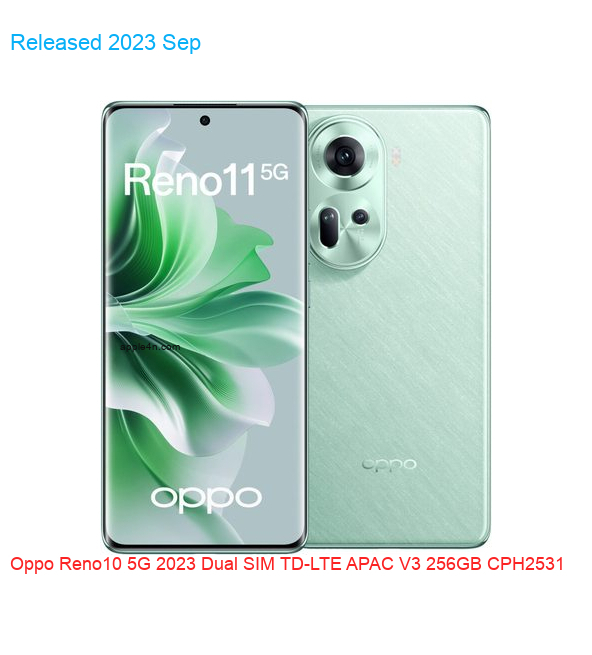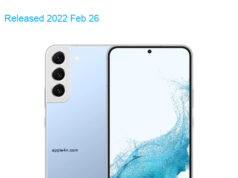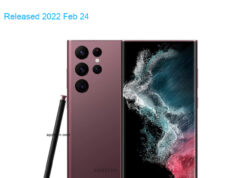| Brand | Oppo |
| Model | Reno10 5G 2023 Dual SIM TD-LTE APAC V3 256GB CPH2531 |
| Released | 2023 Sep |
| Announced | 2023 Jul 8 |
| Hardware Designer | Oppo |
| Manufacturer | BBK Electronics |
| Codename | BBK 2531 |
| General Extras | Haptic touch feedback |
| Device Category | Smartphone |
| Width | 74.19 mm |
| Height | 162.43 mm |
| Depth | 7.99 mm |
| Dimensions | 2.92×6.39×0.31 inches |
| Mass | 185 g |
| Platform | Android |
| Operating System | Google Android 13 (Tiramisu) |
| Software Extras | Voice Command , Navigation software , Intelligent personal assistant , Voice Recognition , Face Recognition |
| CPU Clock | 2600 MHz |
| CPU | MediaTek Dimensity 7050 MT6877V/TTZA, 2023, 64 bit, octa-core, 6 nm, ARM Mail-G68 GPU |
| RAM Type | LPDDR4x SDRAM |
| RAM Capacity (converted) | 8 GiB RAM |
| Non-volatile Memory Interface | UFS 2.2 |
| Non-volatile Memory Capacity (converted) | 256 GB ROM |
| Display Hole | 1-hole |
| Display Diagonal | 170.2 mm |
| Resolution | 1080×2412 |
| Horizontal Full Bezel Width | 4.64 mm |
| Display Area Utilization | 89.7% |
| Pixel Density | 394 PPI |
| Display Type | AM-OLED display |
| Number of Display Scales | 1073.7M |
| Display Refresh Rate | 120 Hz |
| Scratch Resistant Screen | DragonTrail Star 2 |
| Graphical Controller | ARM Mali-G68MP4 |
| GPU Clock: | 800 MHz |
| A/V Out | No |
| Microphone(s) | stereo |
| Loudspeaker(s): | stereo |
| Audio Output: | USB Type-C |
| Supported Cellular Bands | GSM900 , GSM1800 , UMTS2100 (B1) , UMTS900 (B8) , LTE2100 (B1) , LTE1800 (B3) , LTE2600 (B7) , LTE900 (B8) , LTE800 (B20) , LTE700 (B28) , TD-LTE2600 (B38) , TD-LTE2300 (B40) , TD-LTE2500 (B41) , NR2100 (N1) , NR1800 (N3) , NR2600 (N7) , NR900 (N8) , NR800 (N20) , NR700 (N28) , TD-NR2600 (N38) , TD-NR2300 (N40) , TD-NR2500 (N41) , TD-NR3700 (N77) , TD-NR3500 (N78) bands |
| Supported Cellular Data Links | GPRS , GPRS MSC33 , EDGE , EDGE MSC33 , UMTS , HSUPA , HSUPA 5.8 , HSDPA , HSPA+ 21.1 , DC-HSDPA 42.2 , LTE , LTE 100/50 , LTE 150/50 , LTE 300/50 , LTE 300/75 , LTE 300/100 , LTE 400/150 , LTE 450/50 , LTE 450/100 , LTE 600/50 , LTE 600/100 , LTE 1000/100 , NR 1500 , NR 2600 data links |
| SIM Card Slot | Nano-SIM (4FF) |
| Complementary Phone Services | Voice transmission , Voice speaker , Vibrate , Speakerphone , ANC , HD Voice , VoLTE |
| Dual Cellular Network Operation | Dual standby |
| Sec. Supported Cellular Networks: | GSM900 , GSM1800 , UMTS2100 (B1) , UMTS900 (B8) , LTE2100 (B1) , LTE1800 (B3) , LTE2600 (B7) , LTE900 (B8) , LTE800 (B20) , LTE700 (B28) , TD-LTE2600 (B38) , TD-LTE2300 (B40) , TD-LTE2500 (B41) , NR2100 (N1) , NR1800 (N3) , NR2600 (N7) , NR900 (N8) , NR800 (N20) , NR700 (N28) , TD-NR2600 (N38) , TD-NR2300 (N40) , TD-NR2500 (N41) , TD-NR3700 (N77) , TD-NR3500 (N78) |
| Sec. Supported Cellular Data Links: | GPRS , GPRS MSC33 , EDGE , EDGE MSC33 , UMTS , HSUPA , HSUPA 5.8 , HSDPA , HSPA+ 21.1 , DC-HSDPA 42.2 , LTE , LTE 100/50 , LTE 150/50 , LTE 300/50 , LTE 300/75 , LTE 300/100 , LTE 400/150 , LTE 450/50 , LTE 450/100 , LTE 600/50 , LTE 600/100 , LTE 1000/100 , NR 1500 , NR 2600 |
| Sec. SIM Card Slot | Nano-SIM (4FF) |
| Touchscreen Type | Capacitive multi-touch screen |
| Expansion Interfaces | TransFlash , microSD , microSDHC , microSDXC |
| USB | USB 2.0 |
| USB Services | USB charging , USB fast charging , USB Host , USB OTG 1.3 , USB OTG 2.0 , USB PD , USB PD 2.0 , USB PD 3.0 |
| USB Connector | USB C reversible |
| Max. Charging Power | 67.0 W |
| Bluetooth | Bluetooth 5.3 |
| Wireless LAN | 802.11a , 802.11b , 802.11g , 802.11n , 802.11ac , 802.11ax |
| Wireless Services | Wi-Fi Direct , Wi-Fi Tethering , WiDi |
| NFC | NFC A , NFC B |
| IR | Yes |
| FM Radio Receiver | No |
| Complementary Satellite Services | Simultaneous GPS , A-GPS , Dual-frequency GPS , Geotagging , QuickGPS , QZSS |
| Supported GLONASS protocol(s) | L1OF |
| Supported Galileo service(s) | E1 |
| Supported BeiDou system (BDS) | B1I BeiDou receiver |
| Camera Placement | Rear |
| Camera Image Sensor | BSI CMOS |
| Image Sensor Pixel Size | 0.70 micrometer |
| Number of effective pixels | 63.7 MP camera |
| Aperture (W) | f/1.70 |
| Zoom | 2.0 x optical zoom |
| Focus | PD AF |
| Video Recording | 3840×2160 pixel |
| Flash | single LED |
| Camera Extra Functions | EIS , EIS (video) , Pixel unification , HDR photo , HDR video , Red-eye reduction , Slow motion video , Burst mode , Refocus , Touch focus , Panorama Photo , Face detection , Face tagging , Smile detection , Face retouch , Face retouch (video) , Intelligent scene detection |
| Aux. Camera Image Sensor | BSI CMOS |
| Aux. Cam. Image Sensor Pixel Size | 1.12 micrometer |
| Aux. Camera Number of Pixels | 8.0 MP aux. cam |
| Aux. Camera Aperture (W) | f/2.20 |
| Aux. Camera Extra Functions | HDR photo , Burst mode , Panorama Photo , Face detection , Face tagging , Smile detection , Face retouch |
| Aux. 2 Camera Image Sensor | BSI CMOS |
| Aux. 2 Camera Number of Pixels | 32.0 MP aux. 2 cam |
| Aux. 2 Camera Aperture (W) | f/2.00 |
| Aux. 2 Cam. Min. Equiv. Focal Length | 46.7 mm |
| Aux. 3 Camera Image Sensor | No |
| Aux. 4 Camera Image Sensor | No |
| Secondary Camera Placement | Front |
| Secondary Camera Sensor | BSI CMOS |
| Secondary Camera Number of pixels | 32.0 MP sec. cam |
| Secondary Aperture (W) | f/2.40 |
| Secondary Camera Focus | PD AF |
| Secondary Video Recording | 1920×1080 pixel |
| Secondary Camera Extra Functions | EIS , EIS (video) , HDR photo , HDR video , Burst mode , Panorama Photo , Face detection , Face tagging , Smile detection , Face retouch , Face retouch (video) , Intelligent scene detection |
| Sec. Aux. Cam. Image Sensor | No |
| Built-in compass | Yes |
| Built-in accelerometer | 3D accelerometer |
| Built-in gyroscope | Yes |
| Additional sensors | In-screen FP sensor , L sensor , P sensor , Step counter |
| Protection from solid materials | Yes |
| Protection from liquids | Yes |
| Battery | Li-ion |
| Battery Cells in Parallel | Yes |
| Nominal Battery Voltage | 3.89 Volts |
| Nominal Battery Capacity | 5000 mAh battery |
| Nominal Battery Energy | 19.45 Wh |
| Market Countries | Australia , HK , Malaysia , Singapore , Thailand , Vietnam |
| Market Regions | Asia , Australia , Southeast Asia |
| Added | 2025-01-31 |
Specifications data description of this 📱Oppo Reno10 5G 2023 Dual SIM TD-LTE APAC V3 256GB CPH2531📱
Title: Oppo Reno10 5G 2023 Dual SIM TD-LTE APAC V3 256GB CPH2531: The Ultimate Specification Guide 📊
Introduction:
Welcome to the ultimate specification guide for the Oppo Reno10 5G 2023 Dual SIM TD-LTE APAC V3 256GB CPH2531. This device is a powerhouse of technology and innovation, designed to meet the needs of the modern user. In this guide, we will take a closer look at the lineup, design, and specifications of this incredible device. 🚀
Lineup:
The Oppo Reno10 is a part of the Reno series, which is known for its cutting-edge technology and innovative design. This device is the latest addition to the series and has been specifically designed for the APAC market. It is available in a single variant – the 256GB CPH2531 model.
Design:
The Oppo Reno10 has a sleek and stylish design, with a slim body and a 6.8-inch bezel-less display. It is available in two colors – Starlight Black and Aurora Blue. The device has a glass back and a metal frame, giving it a premium look and feel. The cameras are neatly arranged in a rectangular module at the back, giving it a minimalistic and elegant appearance.
Specifications:
Now, let’s take a closer look at the specifications of the Oppo Reno10.
🌐NETWORK:
The device supports dual SIM TD-LTE and 5G networks, providing users with lightning-fast internet speeds.
📅LAUNCH:
The Oppo Reno10 was launched in the first quarter of 2023.
🏋️BODY:
The device has a dimension of 164.2 x 75.6 x 8.4 mm and weighs 190g.
🌈 DISPLAY:
The device features a 6.8-inch OLED display with a resolution of 2400 x 1080 pixels and a refresh rate of 120Hz. The display has a peak brightness of 500 nits and supports HDR10+.
🤖 OS 🛠️:
The device runs on ColorOS 13.0, based on Android 13.
🚀 Chipset 🔧:
The device is powered by the Qualcomm Snapdragon 8 Gen 2 chipset, which provides smooth and efficient performance.
💪 CPU 🖥️:
The device is equipped with an Octa-core CPU with a clock speed of up to 3.0GHz.
🎮 GPU 💻:
The device comes with the Adreno 740 GPU, providing users with stunning graphics and gaming performance.
🧠 MEMORY 🗂️:
The device comes with 12GB of RAM and 256GB of internal storage.
📷 CAMERA 🎥:
The device features a quad-camera setup at the back, which includes a 50MP primary sensor, a 16MP ultrawide sensor, a 13MP telephoto sensor, and a 2MP depth sensor. The front camera is a 32MP sensor.
🔈 SOUND 🎵:
The device supports dual stereo speakers with Dolby Atmos.
📡 COMMS 📶:
The device supports Wi-Fi 6E, Bluetooth 5.2, NFC, and GPS.
💡 FEATURES 🎁:
The device comes with a host of features, including an in-display fingerprint scanner, face unlock, IP68 water and dust resistance, and a 3.5mm headphone jack.
🔋 BATTERY🔌:
The device comes with a 5000mAh battery and supports 65W fast charging.
Conclusion:
The Oppo Reno10 5G 2023 Dual SIM TD-LTE APAC V3 256GB CPH2531 is a device that truly lives up to its expectations. With its cutting-edge technology, premium design, and incredible features, it is the perfect choice for anyone looking for a high-performance smartphone. We invite you to leave a comment and share your thoughts on this device. 😊








